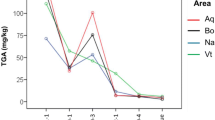Abstract
Since glycoalkaloids have been shown to have fungitoxic properties, it is important to know what impact this might have on potato plant breeding programs which select for low levels of total glycoalkaloids (TGA) in the tuber. Potato clones with TGA levels ranging between 1.6 and 32.8 mg/100 g fresh tissue were planted in two trials to evaluate the relationship between seed tuber TGA and incidence ofRhizoctonia solani infection in the developing plant. An inoculation procedure was followed in the greenhouse and field to establish uniform infection of potato seedlings. Plants were examined for lesion development on stems and stolons and assigned disease ratings. In the field, yield of malformed tubers was recorded and included in the overall disease ratings. The results reported herein indicate that TGA levels in the seed tuber are unrelated to the severity ofR. solani infection in the seedling.
Similar content being viewed by others
Literature Cited
Allen, E.H. and J. Kuć. 1964. Steroid alkaloids in the resistance of white potato tubers. Phytopathology 54:886 (Abstr.).
Allen, E.H. and J. Kuć. 1968. α-Solanine and α-chaconine as fungitoxic compounds in extracts of Irish potato tubers. Phytopathology 58:776–781.
Bushway, R.J., A.M. Wilson, and A.A. Bushway. 1980. Determination of total glycoal- kaloids in potato tubers using a modified titration method. Am Potato J 57:561–565.
Deahl., K.L., R.J. Young, and S.L. Sinden. 1973. A study of the relationship of late blight resistance to glycoalkaloid content in fifteen potato clones. Am Potato J 50:248–253.
Frank, J.A., S.S. Leach, and R.E. Webb. 1976. Evaluation of potato clone reaction toRhizoctonia solani. Plant Dis Rptr 60:910–912.
Frank, J.A., J.M. Wilson, and R.E. Webb. 1975. The relationship between glycoalkaloids and disease resistance in potatoes. Phytopathology 65:1045–1049.
Goth, R.W., S.L. Sinden, and M.J. O’Brien. 1969. Effect of light and glycoalkaloids on lesion development caused byAltemaria solani on potatoes. Phytopathology 59:1556 (Abstr.).
Kuć, J., A. J. Ullstrup, and F.W. Quackenbush. 1955. Production of fungistatic substances by plant tissue after inoculation. Science 122:1186–1187.
McKee, R.K. 1959. Factors affecting the toxicity of solanine and related alkaloids toFusarium coeruleum. J Gen Microbiol 20:686–696.
Paquin, R. 1966. Study on the role of the glycoalkaloids in the resistance of potato to bacterial ring rot. Am Potato J 43:349–354.
Sanford, L.L. and S.L. Sinden. 1972. The inheritance of potato glycoalkaloids. Am Potato J 49:209–217.
Sinden, S.L., R.W. Goth, and M.J. O’Brien. 1973. Effect of potato alkaloids on the growth of Alternaria solani and their possible role as resistance factors in potatoes. Phytopathology 63:303–307.
Willimot, S.C. 1933. An investigation of solanine poisoning. Analyst 58:431–439.
Wolf, M.J. and B.M. Duggar. 1946. Estimation and physiological role of solanine in the potato. J Agr Res 73:1–32.
Author information
Authors and Affiliations
Rights and permissions
About this article
Cite this article
Morrow, L.S., Caruso, F.L. Effect of potato seed tuber glycoalkaloid content on subsequent infection byRhizoctonia solani . American Potato Journal 60, 403–407 (1983). https://doi.org/10.1007/BF02877246
Received:
Issue Date:
DOI: https://doi.org/10.1007/BF02877246




